For centuries, people have been transporting their goods by water. Today, maritime transportation has evolved into a highly complex industry, the backbone of international trade, carrying up to 90 percent of traded goods.
Ship chartering is one of the most common types of interaction in the world of sea transport. If you’re looking for ways to streamline such chartering processes as finding the right vessel and estimating voyages, read on. In this article, we’re going to describe how chartering works and how technology can make it easier for you.
What is maritime chartering?
Maritime or ship chartering refers to an agreement between a ship owner and a cargo owner in which the former hires out a vessel to the latter to ship freight. Such a rental contract is called a charter party. It outlines all the details of an agreement such as the route, cargo type, crew information, rate, and other terms.
In the shipping industry, various chartering scenarios are possible. Let’s outline a few common ones and at the same time define the main players.
Typical ship chartering scenarios
So, you need a ship to transport your goods. Where should you go? Well, here are your options.
Some common ship chartering scenarios
Scenario 1: hire from a ship owner
The most obvious one (though not the simplest) is hiring directly from a ship owner. For example, you are a US-based oil company that wants to export crude oil to Europe. You can look for a vessel on a ship chartering marketplace (such as OpenSea or Shipnext) or contact a carrier (say, Maersk) directly. In this case, you are a shipper, a cargo owner, and a charterer, while the carrier is a ship owner and a ship operator.
To opt or not?
On one hand, you deal directly with the ship owner which is more transparent and facilitates communication and also you don’t have to pay commission to intermediaries. On the other hand, you’ll have to find information yourself, sift through multiple options, and negotiate about the price and other contract terms which requires time and expertise.
Scenario 2: get help from a broker
Another typical scenario is dealing with the broker. A ship broker is the intermediary between ship owners and ship charterers who brings them together and receives commission for facilitating the chartering agreement (in the shipping industry such vessel booking is called fixture.) You can read how freight brokerage business works in trucking in a separate post.
To opt or not?
Working with the brokers allows you to avoid the search and negotiation hassle. However, their services might be pricey and having that extra link might make communication more difficult and cause misunderstandings.
NB: Don’t confuse brokers and freight forwarders, who also act as transportation intermediaries. The difference between the brokers and freight forwarders is that brokers never take possession of cargo and don’t carry responsibility, they only connect shippers and carriers and make arrangements on behalf of someone else. Meanwhile, freight forwarders physically and legally take charge of the items in transit, arrange their storage, consolidation, and transportation, and issue their own bill of lading.
So, to sum up, you can partner with a freight forwarder to ship your goods and actually it’s a common way to solve the transportation problem, but it won’t be chartering anymore (at least for you).
Scenario 3: hire from another charterer
The chains in the chartering process can be longer and more complicated, involving multiple charterers and/or brokers. For example, an NVOCC ABC charters the ship from a bank for, say, 10 years (NVOCCs or non-vessel operating common carriers are transportation companies that don’t own their fleet and have to lease cargo space from ship owners.)
During this time, this company ABC can lease this ship to you for separate voyages or shorter terms (read on to learn about main charter types). In this case, you will be a sub-charterer, and ABC will be the disponent owner (one taking the place of the legal owner), with corresponding rights and liabilities.
To opt or not?
Frankly speaking, for you as a shipper, there’s no big difference who to rent the vessel from (from a legal standpoint). What matters more is the pricing and reputation of the company you want to partner with.
Okay, so you found a vessel. Now, you have to decide on the type of chartering contract.
Types of ship chartering
There are three main types of charter contracts, depending mainly on the lease term and division of management responsibilities.
Main types of charter contracts
A voyage charter is hiring the ship and the crew for a trip from a load port to a discharge port. In this case, a ship owner pays the port costs, fuel costs, and crew costs. The owner also retains management of the vessel through its own crew.
The parties agree on the voyage duration (called laytime) and amount of cargo to be carried. You’ll have to pay the rental payment that is called freight and is calculated on a per-ton (weight) or a lump sum basis.
A time charter refers to hiring a vessel for a certain period of time for a remuneration called hire, which is either a fixed daily rate or a monthly rate per ton deadweight. In this scenario, a ship owner continues to manage the ship, but you are going to pay all the expenses incurred and take operational control, i.e., choose the vessel route, speed, and ports to dock.
A demise charter, or bareboat charter, refers to hiring a ship with no administration or technical maintenance included. Here, you take full legal and financial responsibility for the vessel, get total control (including crew appointment), and bear all operational expenses (fuel, port fees, crew wages, insurance, etc.). In many cases, it works as a hire-purchase, i.e., at the end of such a charter, you obtain the ownership of the ship.
Chartering process
Having covered the basics, the main question still stands -- what exactly should you do to move that freight? Well, there are a number of processes inside ship chartering, such as
- finding a vessel to ship cargo,
- building optimal routes,
- estimating and comparing voyage profitability,
- tracking ships, and
- creating reports, monitoring performance, and analyzing the market situation.
You probably can do all that manually, using spreadsheet databases (that become outdated the minute after they're created), calling ports for information on their bunker prices and traffic (those change every minute too), making navigation calculations (that part might require a PhD), and guessing what the weather on your way is going to be like (and sometimes voyages take months -- sounds like a bit too complicated and uncertain, doesn’t it??)
Well, that’s not really efficient (duh..). You can go through it once, but if you want to build a continuous, high-performing shipping flow, let’s talk about the role technology plays in maritime chartering and how it can help you with your daily operations.
Maritime chartering software and its key features
Today, there are specialized tools that can streamline and automate your chartering processes. Let’s look at the functionality of such software that addresses the most common problems of charterers (note that we're not promoting any specific software provider, but we’ll mention some vendors for the sake of example.)
Main modules of ship chartering software
Finding vessels
One of the central features of chartering software that will probably be of the biggest help to you is complete, relevant databases. Once you need to find a vessel that fits your needs, you can open a vessel database that contains current information about thousands of ships worldwide, including such details as
- ship ownership,
- vessel specs,
- last fixtures,
- status (idle or fixed),
- position,
- commercial managers, etc.
So, you can easily search available ships for your freight in a specific area, compare rates and performance indicators, and make an informed choice.
Vessel list with filters applied in the Signal Ocean platform
Routing
If you chose to operate the chartered vessel yourself, you’ll have to handle the routing. In the maritime shipping industry, that means creating optimal, most cost-effective routes having in mind navigation safety, fuel consumption, and environmental impact.
Besides such obvious factors as physical distances and weather, you have to consider the International Maritime Organization (IMO) regulations and also decide on whether or not you want to avoid certain areas that might delay your voyage (such as piracy zones, canals, and Emission Control Areas known as ECAs).
With the help of the routing software, you can build, assess, and compare different routing options and make a conscious decision knowing the pros and cons of each one.
Tip: Make sure that the tool you chose is IMO 2020 compliant, has powerful global weather forecasting capabilities, and can build routes for different vessel and cargo types. Also look for the ones that offer optimization recommendations (such as optimal speed) and allow you to set environmental restraints and different route objectives, e.g., least time, least cost, etc.
Voyage estimation
A ship voyage estimation is one of the central activities that is closely related to routing, but primarily aims at forecasting expenses and revenues from each voyage.
You need to estimate voyages for two main reasons. First, if you operate the ship, you have to compare different estimations to know the related costs and choose the voyage option that would be most profitable. Second, estimating voyages for different ships from various owners will give you the understanding of their revenue expectations, which, in turn, will support the negotiation process.
Making manual estimations is lengthy and inefficient since for every vessel type, be it a tanker or dry cargo ship, the calculations are different and have to take into account numerous factors such as
- distance between ports,
- vessel specs (type, deadweight, stowage, etc.),
- cargo type,
- bunker prices,
- loading time,
- port congestion,
- weather, etc.
With the help of software, you can easily create multiple estimates and see how different factors impact financial results.
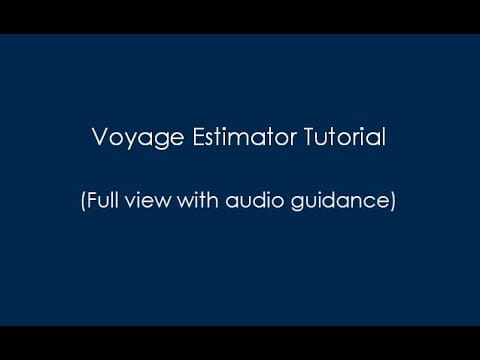

Check a video tutorial of Magellan voyage estimator
Tip: Note that a good voyage estimation software is not only connected to the relevant industry-specific databases, but also contains information on weather forecasts, up-to-date prices (port fees, canal costs, bunker, stevedoring, etc.), holiday calendars in different countries, and other useful data. You should be able to combine multiple cargo types with different loading/discharging rates at different loading/discharging ports and also to predict risks such as demurrage or other delays.
Scenario comparison
After creating multiple estimates for various voyage scenarios, it’s important to compare them side by side. Software allows you to analyze voyage duration and profitability and get insights on how to maximize your profit. Also, you can create and compare freight calculations and select the most cost-effective cargoes.
Tracking
Tracking the vessel position and activities is important not only to have the peace of mind and rest assured that everything goes right. Monitoring the voyage progress helps with maneuvering and correcting the route if necessary.
You can get real-time information about your vessel’s location (as well as that of other ships) and activities through chartering software that is connected to the satellite and terrestrial AIS (automatic identification system).
You can also conveniently visualize voyage and vessel-related information with the help of an interactive map. Such tracking capabilities serve as a basis for creating a global vessel database and support the search and routing processes.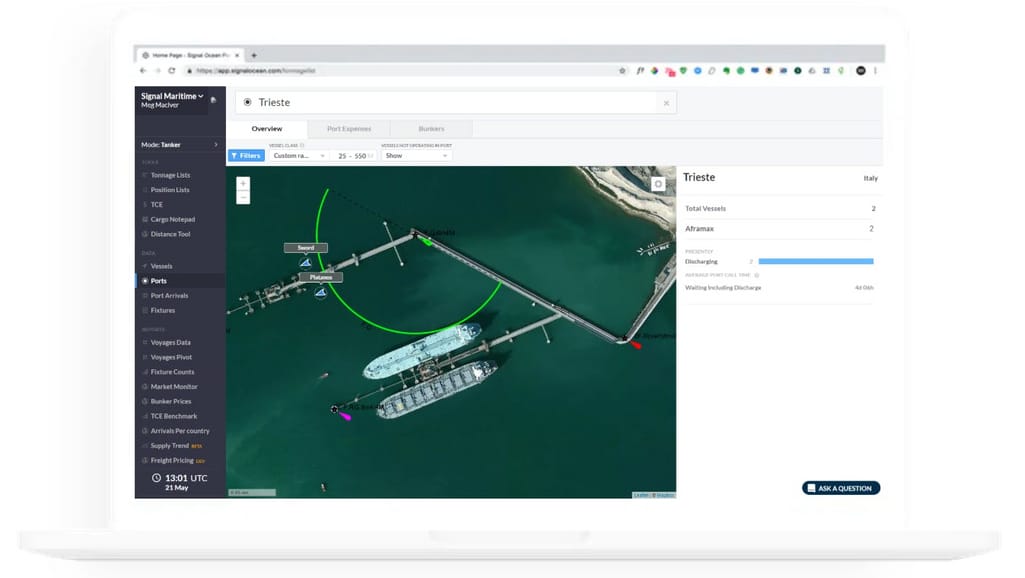
Monitoring vessel activity in the port with the help of satellite AIS (Signal Ocean platform)
Reporting and analytics
The transportation industry is impacted by numerous factors and generates huge volumes of data related to vessels, ports, routes, cargoes, rates, trading patterns, and much more. Brokers, ship owners, and charterers have to collect and analyze the real-time shipping market information to get a holistic, detailed view of the situation, gain competitive advantage, and make profit-generating decisions. Such critical industry data includes
- vessels database,
- live AIS information,
- port/transshipment areas descriptions, regulations, congestion,
- daily market reports,
- Baltic indices,
- current and historical trade deals and fixtures,
- voyages database, and much more.

Market report in the Shipfix platform
To get all that information, you’ll have to either find a comprehensive system with inbuilt integrations or connect to multiple data sources yourself (we’ll talk more about it in the next section).
You can also consider implementing one of advanced AI-powered tools such as Signal Ocean that are capable of processing your unstructured data extracted from emails, broker fixture reports, and other disparate sources. It enriches your knowledge base and allows you to get a more complete picture.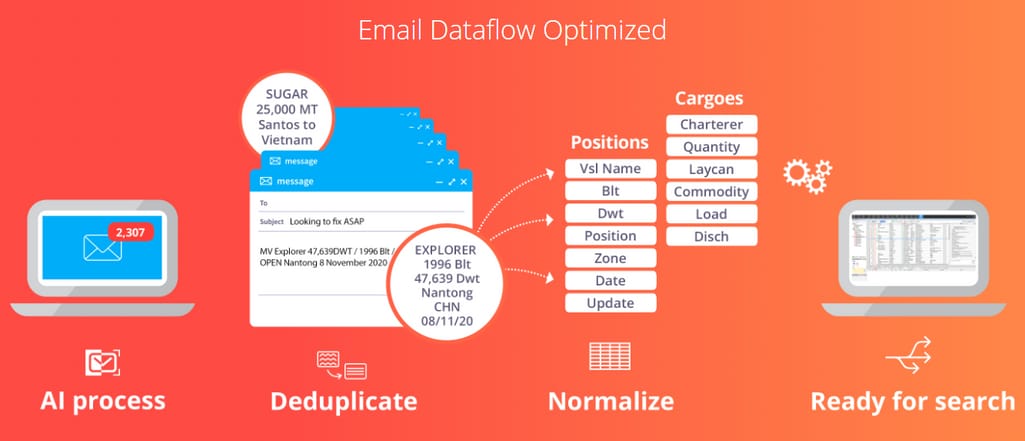
Processing emails flow with AXSReader
With all this data in one system, you can easily see all the necessary information with the help of customized dashboards, streamline core chartering operations, and get a complete picture of your performance. Also, don’t forget to compare estimations made earlier with the actual voyage results to understand the reasons behind any possible discrepancies.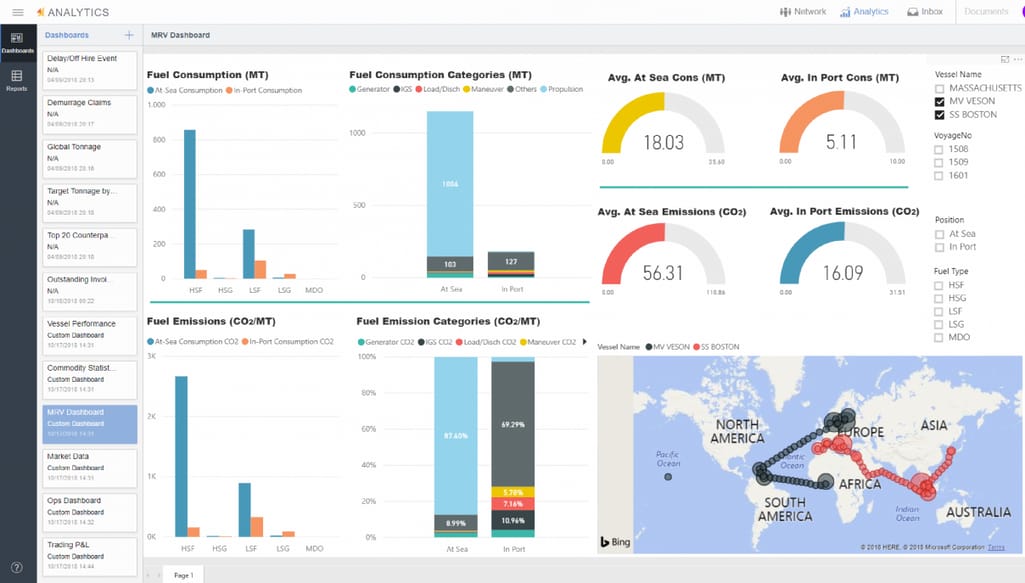
Reporting dashboard in the Veson IMOS Platform
Besides collecting and visualizing data, you can apply various advanced analytics techniques to analyze it, define trends, and make predictions to support your decision-making process. It’s vital for you as a charterer to follow and forecast market trends to be able to estimate the optimal time for making deals and take advantage of most favorable opportunities, especially in the case of long-term planning.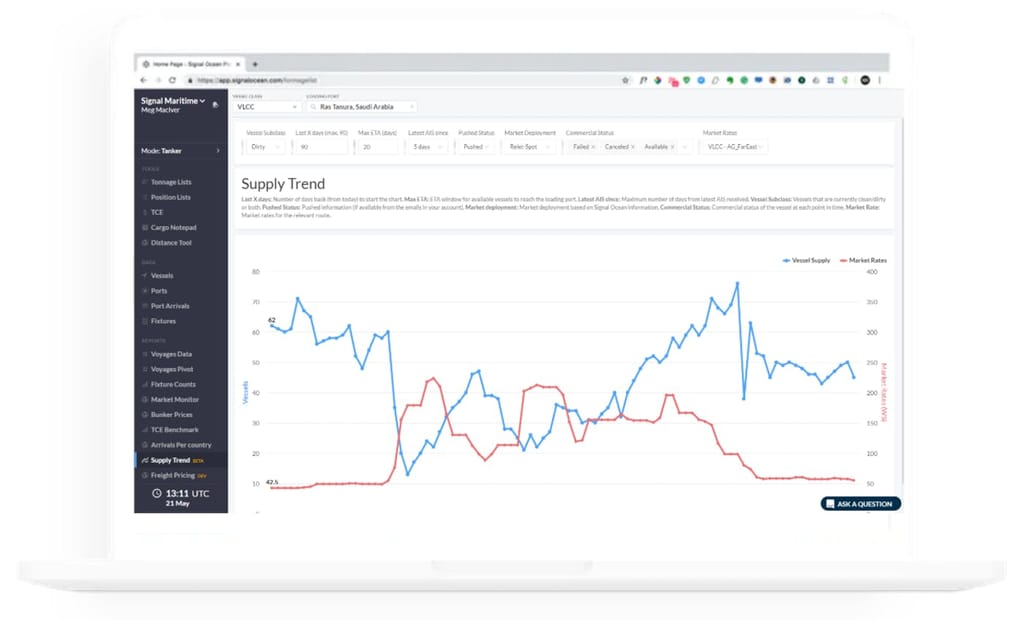
A supply trend report on the Signal Ocean platform showing the ratio of vessel supply and market rates
Tip: Most off-the-shelf chartering systems have an analytics module, but its capabilities are usually quite limited. To make accurate predictions and effectively assess opportunities, consider implementing machine learning techniques.
Other useful software features include a messaging platform to streamline communication between teams, mobile access to the system, contact database, and so on.
Ship chartering software integrations
Obviously, to have all that diverse information we described above, seamless connectivity with multiple data sources and third-party systems has to be established. If you’re not familiar with technical details, check our articles dedicated to the concept of integration in general and APIs (application programming interfaces) as the most usual means of building such a connection.
Depending on your business type and needs, the integrations you should consider building will differ. However, all of them can be divided into two groups.
Ship chartering software integrations
Internal integrations
You probably already have some business management system in use. So, internal integrations have to connect your chartering software with your existing IT infrastructure, such as
- ERP,
- ship/fleet management system,
- accounting software,
- routing tools,
- tracking systems,
- freight management system, or
- any internal databases.
Some providers of finished products partner with third-party software vendors and offer preestablished integration. However, in most cases, you’ll have to involve IT specialists to build the connections between your systems. That will ensure smooth data exchange and support your analytics.
External integrations
As we said, consolidating up-to-date, industry-related information is vital for all your chartering operations, be it vessel finding, tracking, or voyage estimation. So, let’s look at what outside data you might need and where you can get it.
Market reports. Receiving regular marine industry reports will let you in on the latest news, events, and trends. There are analytic companies that offer periodic newsletters, but you can subscribe to, say, the Baltic Exchange and set up an API feed of the most up-to-date maritime information and critical industry indices.
Automatic identification system (AIS). Real-time data from an AIS is the basis for your tracking, routing, and vessel finding activities. Connecting to MarineTraffic, Spire, or Datalastic will provide you with a wide range of data feeds related to vessel positions (and details), marine traffic, weather, and other geographical information. Most providers of such data have well-written API documentation (e.g., Spire) to facilitate the integration process.
Bunker prices. Knowing the current situation on the fuel market and prices in different ports is necessary for accurate voyage estimation and fuel management activities. To get the real-time bunker price data feed in your system, you can connect to ClearLynx or, for example, get a MABUX license to access their APIs and their directory of bunker suppliers, as well as historical and current prices, forecasts, related analytics, and more.
Port costs. Port charges are another significant part of voyage expenses and the challenge is that they fluctuate and differ from terminal to terminal even within one port. So, knowing real-time port fees would allow you to make more precise calculations of the voyage costs.
For comprehensive management of your port calls you can connect to DA-Desk, the leading disbursements accounting platform, or, for example, partner with PortPoint if you just want to receive port-related data.
Information aggregators. There are such providers as VesselsValue that offer API services for a regular data feed of various maritime information straight into your system. You can choose one of the packages or build bespoke API feeds depending on your needs. The AXS API Hub is a similar solution that offers establishing connectivity between their proprietary databases and your own data to enable smooth information flows and in-depth analysis.
And again, as we said, most vendors that offer ready-made chartering software have a certain number of inbuilt integrations and open APIs to create custom connections for their clients.
Implementation tips
To wrap up, we’d like to briefly discuss the main approaches to software implementation.
For example, if you already have software to manage your shipping or brokerage business and you lack certain functionality (such as voyage estimation or vessel tracking), you probably don’t need a full-blown system and the best option is acquiring a specialized tool and integrating it with the rest of your IT infrastructure.
In case you are launching (or developing) a business in the shipping industry, consider partnering with a reliable software vendor and start with getting the most essential modules. As you scale, you can purchase more add-ons for comprehensive management.
Obviously, every business is different and often off-the-shelf software can’t offer enough customization to efficiently support your operations, especially if you manage a big company with multiple processes. In this case, consider developing your own product that will perfectly fit your specific needs, streamline and automate critical business activities, and boost your performance.

Maria is a curious researcher, passionate about discovering how technologies change the world. She started her career in logistics but has dedicated the last five years to exploring travel tech, large travel businesses, and product management best practices.
Want to write an article for our blog? Read our requirements and guidelines to become a contributor.

